 |
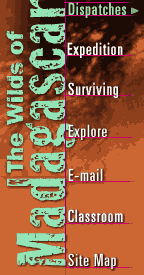  Hear Luke Dollar's
Hear Luke Dollar's imitation of a fossa growl in RealAudio 56k | ISDN Get RealPlayer software |
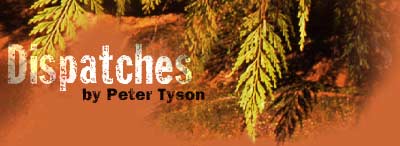 May 25, 2000 Fossa!
"Peter, many happy returns," whispered Nick Gordon urgently through the mesh. "Luke has caught a fossa and is waiting for you." Bleary-eyed, throwing on whatever clothes fell to hand, I stumbled out of my tent and over to the work area of our camp. "Will we take the car?" I asked, rushing to gather my gear. "No, he's just about a kilometer up the road," Gordon said, thrusting a walkie-talkie into my hand. "You've got to hurry." As Angeluc Razafimanantsoa grabbed my camera bag, I stuffed notebook and digital camera into my pockets, snatched up the digital audio recorder from the equipment tent, and headed up the old logging road toward Lac Vert at a smart trot, Angeluc at my side. In a few minutes Luke Dollar appeared ahead. Appropriately enough, he wore a white t-shirt with a drawing of a fossa on it, and he had a boyish grin on his youthful face. With him were Angelin Razafimanantsoa and Leon Pierrot Rahajanirina, a tall, thin Malagasy who is Dollar's graduate student. Dollar shushed us with his index finger to his lips. We slowed and stepped quietly through the leaf litter, the forest pressing close on both sides. "I'm going to do a visual estimate of weight," Dollar said to me under his breath. "You follow behind." We moved down the road a few paces and then Dollar pointed into the woods. Several long strides in lay a rectangular cage of wire mesh the size of a large suitcase. A low, guttural growl came from within, where I could just make out a brown shape bunched up at the far end of the cage, deep in shadow. Suddenly the brown shape exploded, arching its back and bouncing off the cage walls in great contortions, growling furiously. "Back! Back!" Dollar cried as we fell back into the road. "We don't want to stress him." For it was indeed a male, a full adult male. Cryptoprocta ferox, as the fossa is known scientifically, is the largest carnivore unique to Madagascar, and it can reach at least 28 pounds in weight and stretch a full six feet from dog-like snout to tip of long brown tail. Dollar told me there are unsubstantiated reports of fossa up to 44 pounds. Out of sight of the animal, which calmed down when it could no longer see us, Dollar demonstrated the blowgun he uses to anesthetize captured fossa. Pressing his lips to one end of a long black pipe, he blew hard. An orange dart shot out the other end and embedded itself in the trunk of a tree. At the instant it touched the bark, the dart gave off a bright burst of light like a firework. "That's how we'll know it went in," Dollar said.
The dart bounced off. "Back! Back!" Dollar cried. "It didn't take!" We withdrew again to prepare another dart, returning shortly to repeat the procedure. The fossa remained still, and this time the dart took, though somehow I missed the flash of light. "Back! Back!" Dollar yelled once again, and we backed down the road away from the cage. "Ninety seconds," Dollar said, and we waited. When that time had elapsed, Dollar tiptoed toward the cage. "Yup, he's down," he said, though I could see the fossa was still looking right at us and trying his best to stand. He had stopped growling, however, and before we could even reach the cage, the fossa was down on its side, panting quietly, asleep with its cat-like amber eyes open. Dollar opened the cage door and gently pulled the fossa out over the chicken, which the fossa had killed but not eaten. He hefted the animal into his arms and walked out into the road. The fossa was as sleek and feral a mammal as I'd ever seen. Though it's a member of the viverids, the civet and mongoose family, it looked superficially like a panther, with a long, streamlined body covered in brown fur lightening to chestnut underneath, strong legs, and a muscular head with long whiskers and those cat-like eyes. It was clearly designed to kill, with powerful jaws filled with canines as formidable looking as any guard dog's, and long claws on both front and hind feet. "Its feet are reversed," Dollar said, holding up a hind paw, on which the biggest toes lay on the outside rather than on the inside as ours do. "That's so it can grip trees," he added, turning the paw to face inward toward the body. Fossa can run up trees and snatch lemurs before they knew what hit them. Indeed, the fossa, as its species name suggests, has a fearsome reputation, and Malagasy kill it with impunity whenever they get the chance. Dollar is fighting against that tendency by, among other efforts, distributing posters that, beneath a watercolor of a fossa, declare in Malagasy, "SAVE THE FOSSA, SAVE THE HARVEST." Farmers everywhere have great problems with rats and wild pigs destroying their crops both before and after the harvest. The fossa is responsible for keeping populations of these pests naturally low in the forests. So the next time you see a fossa, don't kill it, because it is helping you." He is also training Malagasy like Rahajanirina to become specialists in studying and conserving the fossa and the seven other carnivores that are endemic—found only on Madagascar. The fossa is a keystone species, meaning if it disappears, so might a host of creatures that lie beneath it on the food chain. Dollar estimates the total population at only 2,500 individuals. (Another 50 or so are in captivity.) That number is low enough that the International Union for the Conservation of Nature, which keeps tabs on endangered species, will change the fossa's listing in the next edition of its widely consulted Red Data Book from vulnerable to endangered.
Later, Dollar planned to take the fossa, which would not come fully out of sedation for a few hours, to a large enclosure that Neil Shaw and his Malagasy crew built in the forest. That way Gordon could get some natural-looking footage as the fossa awoke from its harmless slumber. Dollar was not opposed to this. As he put it, "a day's inconvenience for the fossa is worth him serving as an ambassador for Madagascar's wildlife." While they worked, and after Gordon had finished filming, I got in close to the fossa. I ran my thumb over its front claws, which were scraped and torn, possibly from the tsingy. I leaned down to smell its fur, which gave off, as Dollar phrased it, "a wall of musk;" the stench was so powerful I pulled away involuntarily. I bent down and looked into its half-open eyes and daunting mouth, where its tongue moved slowly in and out - a natural reaction to the anesthetic, Dollar said. With Dollar's permission, I even lifted the fossa under the equivalent of its armpits. It weighed only about 17 pounds, but its "dead weight" made it feel far heavier. Looking up, I could see crowned lemurs peering down from on high. What did they think seeing their greatest fear, the forest's most vicious killer, subdued in my arms? For my part, I felt extremely gratified. I'd wanted to see a fossa ever since I'd checked fossa traps with Dollar in Ranomafana National Park in 1997 (with no luck while I was there). And as if not only seeing but holding the fossa was not enough of a birthday present, Dollar topped it off by naming the fossa "Peter." "Not many people have a fossa named after them," Dollar said, smiling, clearly as content as I was. Peter Tyson is Online Producer for NOVA. Check back in tomorrow as we head to the Crocodile Caves in search of the island's most fearsome predator of all, the non-native Nile crocodile. Dispatches Forest of Hope (June 7, 2000) A Great Day for Silkies (June 4, 2000) Camp Life Unveiled (June 3, 2000) Three Hours with the Silkies (June 1, 2000) Angels of Marojejy (May 31, 2000) Wildlife (May 30, 2000) Into the Marojejy Massif (May 28, 2000) Croc Cave (May 26, 2000) Fossa! (May 25, 2000) Bat Cave (May 24, 2000) Update: English Camp (May 23, 2000) Update: Sunken Forest (May 21, 2000) Update: Night Walk (May 20, 2000) Update: 70 Feet Up (May 19, 2000) Update: Tropical Downpour (May 18, 2000) Photos: (1-3) Peter Tyson. The Expedition | Surviving The Wilds | Explore Madagascar Dispatches | Classroom Resources | E-Mail | Resources Site Map | The Wilds of Madagascar Home Editor's Picks | Previous Sites | Join Us/E-mail | TV/Web Schedule About NOVA | Teachers | Site Map | Shop | Jobs | Search | To print PBS Online | NOVA Online | WGBH © | Updated November 2000 |
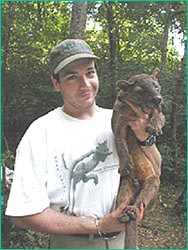 Luke Dollar holds a fossa.
Luke Dollar holds a fossa.
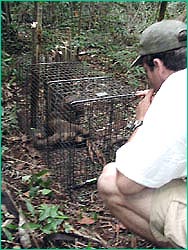 With a low growl emanating from the cage before him, Luke Dollar shoots a dart with anesthetic into the hind quarters of the captured fossa.
With a low growl emanating from the cage before him, Luke Dollar shoots a dart with anesthetic into the hind quarters of the captured fossa.
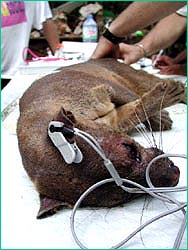 Wearing a device for measuring pulse on its ear, the sedated fossa gets a workup from Luke Dollar and Julie Pomerantz.
Wearing a device for measuring pulse on its ear, the sedated fossa gets a workup from Luke Dollar and Julie Pomerantz.